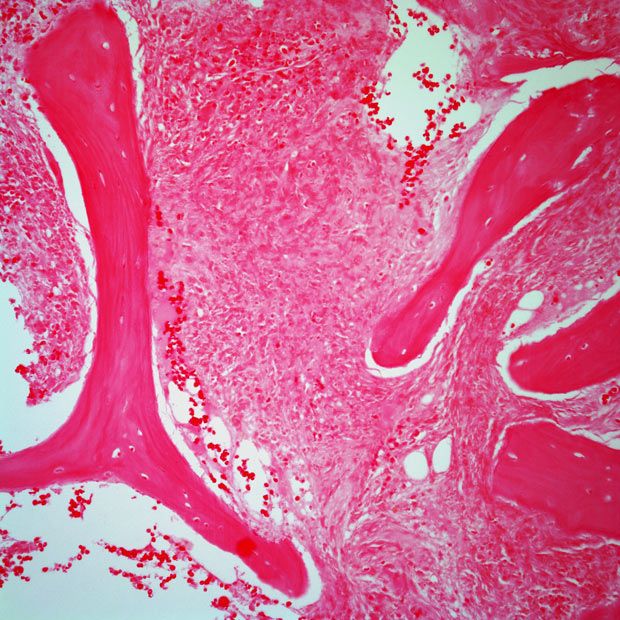BTK Degrader BGB-16673 Shows Promise in R/R WM and CLL/SLL
Findings from the phase 1/2 CaDAnCe-101 trial showed that promising ORRs in R/R WM and R/R CLL/SLL stemmed from BGB-16673 treatment.
Findings from the phase 1/2 CaDAnCe-101 trial showed that promising ORRs in R/R WM and R/R CLL/SLL stemmed from BGB-16673 treatment.

Treatment with the novel Bruton tyrosine kinase (BTK) degrader BGB-16673 has been found to result in a tolerable safety profile as well as promising responses among patients with BTK inhibitor–exposed relapsed/refractory (R/R) Waldenström macroglobulinemia (WM) and heavily pretreated patients with R/R chronic lymphocytic leukemia/small lymphocytic lymphoma (CLL/SLL), study results have shown.
Emerging early data from the ongoing, open-label, first-in-human, phase 1/2 CaDAnCe-101 trial evaluating BGB-16673 as a monotherapy among patients with B-cell malignancies were presented at the 2024 American Society of Hematology Annual Meeting & Exposition (ASH).
Among 27 response-evaluable patients with WM, the objective response rate (ORR) was 81%, while the major response rate (partial response [PR] or better) was 74.1%, and the very good PR rate was 25.9%.1
The median time to first response was 1 (0.9-3.7) month, with researchers reporting that responses deepened over time and 20 patients were still on treatment with ongoing responses. The median follow-up was 5 (0.8-24) months.
Responses were reported among patients receiving the lowest dose (100 mg, 7 of 9 patients) as well as in patients previously treated with a cBTKi (22 of 27 patients) and an ncBTKi (4 of 4 patients). In addition, responses were observed in patients with and without mutations in BTK (with, 10 of 11; without, 11 of 14; unknown, 1 of 2), MYD88 (with, 20 of 24; without, 1 of 2, unknown, 1 of 1), CXCR4 (with, 11 of 12; without, 10 of 13, unknown 1 of 2), and TP53 (with, 12 of 13; without, 9 of 12, unknown, 1 of 2).
Eligible patients had confirmed R/R WM treated with at least two prior therapies, an ECOG performance status of 0 to 2 and adequate organ function, as well as have received an anti-CD20 antibody and, if they are in the United States or European Union, a covalent BTK inhibitor (cBTKi). Patients received BGB-16673 orally daily in 28-cycles, with dose escalation using a Bayesian optimal interval design of 6 planned dose levels, 50 to 600 mg once daily.
Twenty-seven patients with WM were enrolled and treated as of Sept. 2, 2024. Participants’ median age was 73.0 (56-81) years, and they had undergone a median of 3 (2-11) prior therapies, including prior cBTKis (27, or 100%), BCL2 inhibitors (5, or 18.5%) and ncBTKis (4, or 14.8%), while 25 patients (92.6%) had previously been treated with chemotherapy. Eleven (44%) had BTK mutations, 24 (92.8%) had MYD88 mutations, and 12 (48%) had CXCR4 mutations.
Treatment-emergent adverse events (TEAEs) of any grade were reported by 92.6% of patients, with 40.7% reporting grade 3 or higher and 25.9% reporting serious TEAS, and the most common was neutropenia (29.6%; grade 3 or higher, 25.9%).
Researchers reported no incidents of atrial fibrillation, hypertension, febrile neutropenia, or major hemorrhage occurred, and stated that no TEAEs led to treatment discontinuation or dose reduction, no dose-limiting toxicities (DLTs) occurred, and the maximum-tolerated dose (MLD) was not reached. However, one patient died to a TEAE, specifically septic shock that was considered related to disease progression, and one patient died due to disease progression.
Highlights of Findings Among Patients with CLL/SLL
Elsewhere at the ASH Annual Meeting, emerging data were presented regarding the use of BGB-16673 among patients with R/R CLL/SLL.2
Among 49 response-evaluable patients, the ORR of partial response with lymphocytosis or better was 77.6% (38 patients) with a CR/CR with incomplete hematologic recovery rate of 4.1% (2 patients). The ORR was 93.8% (15 patients) at 200 mg dosage, including 1 CR. There was a median time of 2.8 (2.6-8.3) months until first response, and researchers reported that responses were seen at the lowest dose level (50 mg).
Promising activity was also reported among patients with Richter Transformation, with an ORR of 58.3%, or 7 of 12 evaluable patients, including 1 CR.
Regarding TEAEs, among 60 safety-evaluable patients 56, or 93.3%, experienced any TEAE, with 33 (55%) experiencing grade 3 or higher TEAEs and 16, or 26.7%, experiencing treatment-related grade 3 or higher TEAEs. There was 1 dose-limiting toxicity at the 200 mg dose, grade 3 maculopapular rash, where the patient continued on treatment after a 5-day hold. Seven patients experienced TEAEs leading to treatment discontinuation, with 2 of those related to treatment. Three patients experienced fatal TEAEs, with none of those considered related to treatment.
Researchers reported no atrial fibrillation or pancreatitis, but 2 cases of major hemorrhage (1 each grade 1 and 3) and 1 case of febrile neutropenia.
Patients’ median age was 70 (50-91) years, and they had undergone a median of 4 (2-10) prior lines of therapy, including prior cBTKis (56, or 93.3%), BCL2 inhibitors (50, or 83.3%), chemotherapy (43, or 71.7%) and noncovalent BTK inhibitors (ncBTKis; 13, or 21.7%). Eighteen of 54 (33.3%) had a BTK mutation present, and 8 of 54 (14.8%) had a PLCG2 mutation present.
References
- Seymour JF, Tam CS, Cheah CY, et al. Preliminary efficacy and safety of the bruton tyrosine kinase degrader BGB-16673 in patients with relapsed or refractory waldenström macroglobulinemia: results from the phase 1 CaDAnCe-101 study. Presented at: 2024 American Society of Hematology Annual Meeting; December 7-10, 2024; San Diego, California. Abstract 860.
- Thompson MC, Parrondo RD, Frustaci AM, et al. Preliminary efficacy and safety of the bruton tyrosine kinase degrader BGB-16673 in patients with relapsed or refractory chronic lymphocytic leukemia/small lymphocytic lymphoma: results from the phase 1 CaDAnCe-101 study. Abstract 885.
Newsletter
Stay up to date on recent advances in the multidisciplinary approach to cancer.
Highlighting Insights From the Marginal Zone Lymphoma Workshop
Clinicians outline the significance of the MZL Workshop, where a gathering of international experts in the field discussed updates in the disease state.